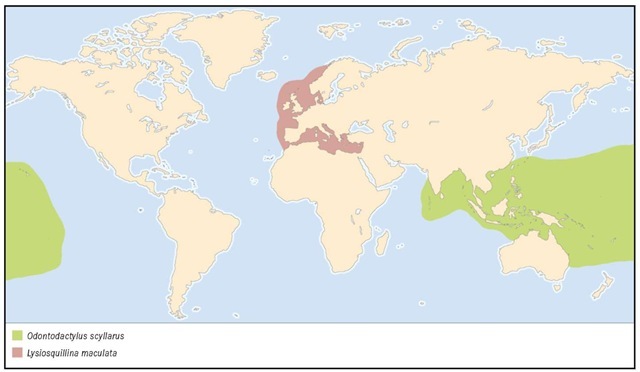Stomatopoda
(Mantis shrimps)
Phylum Anthropoda
Subphylum Crustacea
Class Malacostraca
Number of families 17
Thumbnail description
Predatory, shrimplike crustaceans with acute vision and complex behavior that subdue prey and defend themselves by means of specialized forelimbs modified with stabbing spines or heavily calcified “elbows” used as clubs
Photo: Orange mantis shrimps (Lysiosquilla sp.) live in burrows and prey on small fishes which they “spear” with their sharp claws.
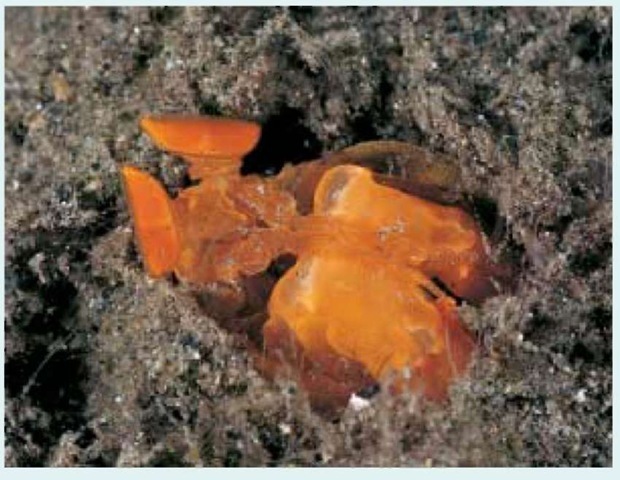
Evolution and systematics
Order Stomatopoda, whose member species are commonly called mantis shrimps or mantis prawns, is included within phylum Arthropoda, subphylum Crustacea, class Malacostraca, and subclass Hoplocarida (“armed shrimp”). The Stomatopoda are sorted into five superfamilies, 17 families, 109 genera, and about 450 species. Mantis shrimps are also commonly called stomatopods, prawn killers, squilla, thumb-splitters, and split-toes; the last two names were coined by fishermen who found out the hard way about mantis shrimp weaponry.
Mantis shrimps are only distant relatives of shrimps and lobsters, despite the inclusion of “shrimp” in the common name and the superficial resemblance between mantis shrimps and shrimps. The Stomatopoda diverged from other mala-costracans (which include lobsters, crabs, and shrimp) about 400 million years ago. The raptorial appendages evolved their initial forms around 200 million years ago.
Physical characteristics
A typical mantis shrimp looks, at first glance, like an elaborated, elongated shrimp, with stalked eyes and, according to species, may sport brilliant splashes or coats of garish colors, or may be more cryptically colored. Colors vary considerably among and within species, and between sexes. The body may be cylindrical or somewhat flattened dorsoventrally. The thorax is shield-shaped and the abdomen is conspicuously segmented. At the front of the head, moveable somites bear the eyes and double antennae. The prominent, stalked eyes are often vividly colored iridescent emerald, ruby, or sapphire.
Eight pairs of limbs arise from the thorax. The front-most five limb pairs, the maxillipeds, are manipulatory, used in hunting and feeding; the second pair comprises the deadly raptorial appendages, the stomatopods’ most conspicuous claim to fame. Behind the raptorials are three more pairs of maxillipeds, then three pairs of walking limbs, or pereaopods. The abdomen bears five pairs of swimming limbs, the pleopods, which also bear the gills, and ends in an enlarged, fanlike tail, made up of the shieldlike telson, flanked by a pair of uropods, or tail appendages. Stomatopoda (“stomach-mouth”) alludes to the first five pairs of thoracic limbs, since these are used in feeding.
The formidably armed second pair of maxillipeds, the raptorial appendages, are kept folded and tucked away underneath the animal’s head and body when not in use. The folded appendages, still partly visible, account for the “mantis” part of the common name, since they recall the praying mantis, the familiar insect, which rests its raptorial appendages similarly.
All mantis shrimp species, and both sexes, are predatory, but employ only two basic attack modes and appropriate equipment, being either spearers or smashers. The most distal joint, or dactyl, on the second pair of appendages bears, in spearers, an array of dactylar teeth, or spines, and, in smashers, a heavily calcified “elbow” used as a very potent club. The raptorial appendages look and act like jacknives, folded similarly into grooves when at rest, and whipping open and into action in a fraction of a second.
The business edge of a spearer’s raptorial appendage may bear from two to 20 spines, or dactylar teeth, barbed at their tips, efficient and effective arrays of spears for impaling prey, then hauling it in for feeding.
If a stomatopod loses one or both raptorial appendages through injury, it will regrow them gradually over four successive molts. An individual will forcibly remove its own damaged raptorial appendage by use of its other maxillipeds.
Among the five superfamilies, both smasher and spearer species are found in the Gonodactyloidea and Lysiosquilloidea. Superfamilies Squilloidea, Bathysquilloidae, and Erythrosquil-loidea contain only spearers.
The earliest stomatopods, before the evolution of the raptorial appendages, likely fed by grubbing in seabottom mud for resident small creatures, some of which the stomatopods grabbed in the mud while flushing out more mobile types. The fleeing prey prompted the evolution, within the early stomatopods, of elongated, barbed maxillipeds able to flash out and skewer prey on the run. The smasher type of raptorial appendages developed later, probably several different times, from the original barbed appendages.
Stomatopod vision is extraordinarily keen and the eyes are elaborately constructed, being the most highly developed visual organs among crustaceans. Stomatopod eyes are assemblies of ommatidia, or facets, like those in the eyes of other arthropods. However, those assemblies in a central midband region of specialized ommatidia are unique in stomatopods.
The eyes, in a close-up view, have the appearance of highly burnished ovoids with two dark spots and the distinctive mid-band region. The midband region divides the eye into separate hemispheres, each with a pupil and focal point, allowing binocular vision and depth perception in a single eye. The midbrand region also carries its own pupil and focal point, allowing trinocular vision in each eye. Since both eyes each carry three focal points, stomatopod vision is hexnocular, coordinating imagery from six focal points. The eyes are thereby capable of fine-tuned depth perception and range, enabling their owners to be aware of subtleties of speed and distance of prey to be able to attack with fiendish accuracy.
The midband region of the eye, made up of six rows of specialized ommatidia, can perceive color and polarized light. Four rows carry 16 differing sorts of photoreceptor pigments, 12 for color sensitivity, others for color filtering. The pig-mented filters, arrayed within the ommatidia like sunglasses, allow fine-tuning of sensitivity to certain wavelengths of light. The eyes are capable of distinguishing up to 100,000 colors, ranging from infrared through the visible color spectrum and into the ultraviolet. The remaining two rows within the mid-band region are sensitive to polarized light.
The hemispheres are not equipped for color vision and are primarily sensitive to forms. Although the midband region color-scans only a small segment of the stomatopod’s visual field, the animal can move the eyes with delicate precision in a wide range, scanning its environment with the sensitive midland region.
A resting but wary stomatopod will often keep its stalked eyes aloft, like periscopes, achieving 360° vision.
Stomatopods can change the spectral sensitivity of their eyes if descending into deeper waters, where the remaining light is mostly blue and highly polarized. The eyes will adjust to the low, blue-shifted light by becoming more sensitive to the blue end of the visual spectrum.
Supplementing the eyes are the antennae, or antennules, sensitive to water-borne odors and turbulence. A special feature of stomatopod antennae is a leaflike flap, or scale, fringed with hairlike setae, to amplify the sensitivity of the anten-nules. Studies by Caldwell have found that, at least in some species, the antennal scales and the uropods, the paddle-shaped appendages of the tail, reflect polarized light. Cald-well’s findings suggest that by moving the antennae and uropods, and thereby communicating flashes of polarized reflected light, which stomatopod eyes can see, individual animals may communicate with one another. Experiments lend support to the probability that an individual mantis shrimp can detect and identify the odor of another individual of the same species.
Stomatopod sexes can be easily distinguished. Males bear a pair of long, slender penes, or sperm transferal organs, articulating at the bases of the last paraeopods, or walking limbs. The female gonopores, or sperm receptacles, are visible as a narrow slit on the sternum between the first peraeopod pair. Many species go further with sexual dimorphism, the males being bigger, with larger raptorial appendages and telsons than females.
Distribution
Mantis shrimps live offshore of most, if not all, continental landmasses that straddle the tropical and subtropical latitudes, and offshore of tropical and subtropical islands.
Habitat
Stomatopods are primarily tropical or subtropical, shallow-water marine animals, with a few species in cool temperate or subantarctic waters. Most species prefer the intertidal or sub-tidal zones. Exceptions are species of superfamily Bathysquil-loidea, which set up and keep house on outer continental shelf habitats down to 4,920 ft (1,500 m) below sea level.
Spearers prefer soft, sandy, or muddy sea bottoms for homemaking, digging out burrows or moving into burrows abandoned by other creatures. Smashers prefer to seek out and move into suitably shaped and sized hollows in hard substrates such as coral and rock. Species of the Gonodactyloid superfamily favor the hard, rough substrates like rock and coral, and so are the dominant stomatopod species on coral reefs. Species within the superfamilies Squilloidea and Ly-siosquilloidea burrow in soft, level, shallow sea bottoms of sand.
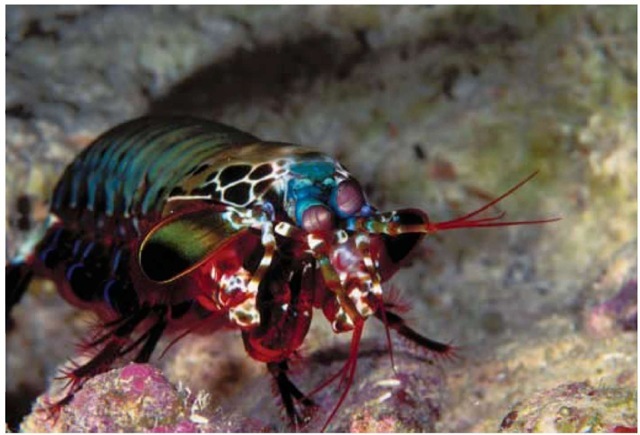
The peacock mantis shrimp (Odontodactylus scyllarus) is a “smasher” species with an incredibly powerful strike capability; it is a favorite among aquarium owners.
Behavior
All aspects of stomatopod behavior are defined or influenced by the animal’s unique raptorial appendages, and that behavior is bewilderingly complex. Mating rituals and competitive interactions between rivals of a species involve elaborate visual communication cues and actions.
Mantis shrimp activity, depending on species, may be diurnal, nocturnal, or crepuscular (dawn and dusk). Some become active during moonlit nights. Males guard pregnant females. Individuals of some species probably recognize other individuals of the same species by sight and odor. So far, stom-atopods are the only invertebrate type in which the ability to tell apart non-mated individuals has been supported by studies. Individual recognition among stomatopoda would be especially important in coral reef habitats, with their limited available cavities. In this high-competition, high-risk environment, it is best to be able to recognize the bullies on the block.
All mantis shrimp species live in soft-substrate burrows or hard rock crevices. Burrow-dwellers either dig out their burrows or move into one abandoned by some other creature. A burrow may be up to 33 ft (10 m) long, and may have several entrances.
When resting, mantis shrimp, depending on species, may plug the burrow entrance with a rock, or position the claws or telson at the entrance. Individuals of the species, Echi-nosquilla guerini, have telsons equipped with spines, suitable to their function as shields for the burrow entrance.
Newly mature individuals of either sex compete for living space. In substrates suitable for burrowing, most commonly sand, the competition can be fierce, but less so than in coral reefs, since malleable sand permits flexibility in where an individual establishes its burrow. Coral reefs, on the other hand, are built of hard material, always limiting the number of crevices available for colonization by mantis shrimps, so that the competition among coral reef stomatopods for living space is intense. It is among the rock-dwelling species that senses are most keen and communication between individuals is most complex.
Size difference is the usual criterion in individual competition, with the larger opponent chasing off the smaller. More similarly sized opponents, when threat displays fail, may go on to a fight. A spat between rivals is a dangerous affair, since the sharp tines of spearers’ raptorials can cut and shred, while the clubbed appendages of smashers can deal a single, fatal blow. In fights, opponents use their flexible telsons as shields and fenders. The battle ends in retreat by one individual or in injury.
A burrowing stomatopod, once ensconced, will defend its home vigorously against other mantis shrimps of the same species, and drive off other marine animals that come too close to the burrow. Depending on size and strength, newcomer stomatopods may force weaker residents out of their burrows or crevices, or the established stomatopod may drive off the intruder.
Burrowing stomatopods show less in-species aggressiveness than do species that live in rock or coral crevices. Competing burrowers generally go through elaborate threat rituals until one admits defeat and leaves, without any actual fighting, since the loser can simply go elsewhere and dig out a new burrow. This sort of flexibility does not exist for stomatopods dependent on rocky crevices for shelter, since the animals cannot carve out new crevices in the tough material; the number of available crevices is always limited. Contenders for crevices have no choice but to fight in earnest. On the other hand, since these are creatures that can kill opponents with a single blow of the raptorial appendage, the rock-dwelling stomato-pod species, for defense, sport the brightest and most varied colors and stage the most elaborate threat behaviors among stomatopod species.
A common but dramatic threat display among stomatopods is the meral spread, in which an individual elevates its thorax and spreads wide its antennules, antennal scales, raptorial appendages, and peraeopods. The display creates an impression of inflated size and exposes a brightly colored depression, the meral spot, on the merus, or proximal segment, of the raptorial appendage. Throughout subclass Hoplocarida, flashing the meral spot is the prelude to attacking the rival, so that displaying the meral spot has an unusually intimidating effect on a rival, even one of another stomatopod species. Gon-odactylus smithii is quick to resort to the meral spread and display, sometimes able to chase off other, more aggressive species with its vivid purple and white meral spots.
The efficacy of the flashed meral spot in banishing rivals seems to depend on how early and how aggressively an individual displays the meral spread in an in-species confrontation. Victory in most cases goes to the individual who displays earlier and more aggressively. Flashing the meral spot early in an encounter between individuals usually ends in victory for the displayer, without a fight ensuing. Females guarding egg clutches are quick to display the meral spread to other stomatopods.
Mantis shrimp molt, or shed and replace, their exoskele-tons, like other arthropods. Molting times vary with species, size, age and reproductive state. Adults of superfamily Gon-odactyloidea molt every three or four months.
Learning experiments on gonodactylid mantis shrimps were carried out by M. J. Reaka, who set up an aquarium furnished with a black-painted flask and no other available cover, introduced a single stomatopod individual from a permanent aquarium, and then noted its behavior and how long it took to locate the entrance and move into the flask. The stomato-pod was allowed to rest within the flask for an hour, then
withdrawn and returned to its original aquarium. A few days later, the same individual was introduced to the testing aquarium and its behavior noted. Each tested individual was exposed to five such trials. The more subsequent the trial, the less time the stomatopod took to find the flask, on the average cutting its time from 52 hours on the first trial to only one hour on the fifth.
Feeding ecology and diet
Typically, a spearer lies in wait at the entrance of its burrow, body tucked within, raptorial claws tucked beneath, head and eyes out and alert for movements of passing, soft-bodied prey like fish and shrimp. When the right victim comes into a vulnerable range, the spearer will strike out and up at the prey animal in an almost invisibly fast extension, impaling and retracting the armed claws. The victim secured, the stomato-pod begins feeding formalities.
Smashers are more likely to roam about, crawling or swimming, as active hunters, depending on mobility, or lack of it, among prey animals, since smashers hunt for creatures with hard exteriors, including shelled mollusks and other crustaceans. A smasher will cripple a crab with multiple punches of the heel to the crab’s claws, legs, and carapace, then drag the battered creature to the mantis’s burrow to be feasted upon at leisure. Smashers deal with snails and clams by toting them back to the burrow, wedging them against the burrow wall, then punching them into fragments, later casting the shell shards from the burrow.
Mantis shrimps are capable of some of the fastest movements in living nature. A stomatopod strike at a prey animal, including the unfolding motion, can pass in 2 milliseconds. The strike of a praying mantis takes 100 milliseconds, the length of time of one human eye blink. Smashers add enormous force to their strike speed. Two of the larger smasher species, Hemisquilla ensigera and Odontodactylus scyllarus, pack a punch nearly equal to the impact of a .22 caliber bullet, powerful enough to break open the double-layered safety glass of public aquariums, which in fact they have done.
Reproductive biology
Most stomatopod species are solitary, with opposite sexes staying together only during mating. But some stomatopod species among families Lysiosquillidae and Nannosquillidae are monogamous, very rare among invertebrates. A monogamous stomatopod pair may remain together as long as both are alive, which can be 15-20 years.
Monogamous stomatopod pairs share one burrow and divide up duties, the female tending the eggs while the male hunts food for himself and the female. In non-monogamous species, the sexes only associate during mating and brooding. Some somatopod species mate any time of the year, while others have well-defined, limited periods of female receptivity that occur just before a female lays eggs.
Males may leave their burrows or crevices and seek out females for mating, or both sexes may roam about, looking for partners. Males perform elaborate mating rituals in front of potential mates. The female makes the final decision as to which male she favors for mating. In non-monogamous species, the female may accept one or several males for mating during any one fertile period.
Stomatopod fertilization is internal, and mating behavior somewhat parallels the mammalian. Males carry a pair of penes, penis-like organs attached to the bases of the last pair of pareopods. During mating, the penes erect themselves much as do mammalian penises. Male and female copulate underside-to-underside, the male inserting the penes into the female gonopores, on her ventral side. The sperm is stored in a small pocket within the body, just behind and within the gonopores.
The female extrudes the fertilized eggs through the gono-pores, where they are fertilized by the stored sperm just before they emerge. The female may not lay her egg mass immediately, but may wait weeks before doing so, waiting for strong ocean currents that are favorable to dispersing the young.
The female uses a gummy exhudate from glands on her ventral thorax to glue the extruded eggs into a single, portable mass that she carries with her or plasters to the wall of her burrow. Hatching may start up to three weeks after the egg mass is laid. A female will tend her eggs from 10 days to two months, depending on species. Hatchlings may remain in the burrow with the mother for a time period of a week to two months, or depart immediately upon hatching, for the pelagic stages of their development. Females of non-monogamous species do not eat while tending the egg mass.
During breeding, the male stomatopod, in both monogamous and solitary species, stands guard over the female before she spawns, and, if a solitary species, only leaves to make or find a new home when the female has spawned. Should he encounter the same female in her burrow while looking for a home, he leaves her undisturbed for up to two weeks after separation. The female, in her burrow, sensing an approaching stomatopod, shunts water currents outward from the burrow and toward the approaching individual with fanning motions of her maxillipeds. The male mate apparently recognizes the female’s scent in the disturbed water, and leaves her alone.
Like many marine life forms, newly hatched stomatopod individuals pass through several distinct stages from hatching to maturity. The cycle from hatchling to adult takes about three months. The early larval stages may be benthic (sea bottom) and passed through within the mother’s burrow, or pelagic (open sea), but all later stages are pelagic. At those
stages the larvae are an abundant component of plankton, and thus a significant food source for plankton-feeding fish. Stom-atopod larvae are translucent, glassy, ephemeral-looking beings with wiry, skeletal bodies and huge, bulbous eyes.
A typical larva of superfamily Lysiosquilloidea hatches as an antizoea, with five pairs of biramous thoracic appendages and no abdominal appendages. The antizoea develops into an erichthus, with two or fewer intermediate denticles, or toothlike projections, on the telson, and pleopods sprouting in sequence from front to rear.
A larva of a species within superfamily Squilloidea or Gon-odactyloidea hatches as a pseudozoea, with two pairs of thoracic appendages and four or five pairs of pleopods. A squilloid pseudozoeae develops into an alima, with four or more intermediate denticles on the telson, while a gonodactyloid pseudozoeae develops into an erichthus. The development cycles of superfamilies Erythrosquilloidea and Bathysquilloidea are only poorly known.
Stomatopod postlarvae settle toward the sea bottom, resembling adults at this stage and living in the manner of adults.
Conservation status
No species are listed by the IUCN, and all species are apparently widespread and abundant. Nevertheless, stomatopod species inhabiting coral reefs are vulnerable to depletion because of the massive destruction being wrought on coral reefs through blasting and sewage.
Significance to humans
The presence of stomatopoda can enable ecologists to gauge the health of coral reef ecosystems. Reef-dwelling stomatopods are especially sensitive to adverse conditions such as the introduction of petroleum, sewage, and agricultural runoff. Censuses of stomatopod populations on coral reefs are undertaken frequently to estimate the health or contamination of the reefs.
Keeping mantis shrimps in aquaria has become a fairly popular hobby among marine pet keepers who prefer the unusual. There are topics and Web sites covering aspects of maintaining stomatopods in home aquariums.
Species of the family Squilla are edible and tasty. Originally overlooked as commercial food sources because individuals of most species live solitarily, which makes harvesting difficult, a fishery industry harvesting Squilla mantis is underway in the Mediterranean and Adriatic.
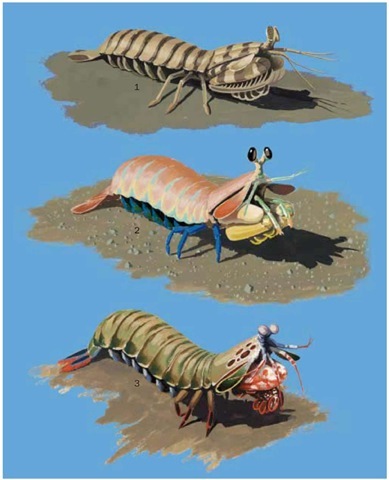
1. Lysiosquillina maculata; 2. Nannosquilla decemspinosa; 3. Peacock mantis shrimp (Odontodactylus scyllarus).
Species accounts
Giant mantis shrimp
Hemisquilla ensigera
FAMILY
Hemisquillidae
TAXONOMY
Two subspecies: Hemisquilla ensigera ensigera (Owen, 1832) and Hemisquilla ensigera californiensis (Stephenson, 1977).
OTHER COMMON NAMES
English: Blueleg mantis shrimp.
PHYSICAL CHARACTERISTICS
A giant among mantis shrimps, adults often reaching a total length of 13.7 in (35 cm) or more. Individuals are brightly colored, with yellow frontal areas, deep blue appendages, and transverse orange-brown stripes across the dorsal abdomen.
DISTRIBUTION
Found off the coast of southern California to the Gulf of California.
HABITAT
Shallow sea bottoms with sand and/or mud and rubble.
BEHAVIOR
Active, aggressive hunter.
FEEDING ECOLOGY AND DIET
A smasher, actively hunts crabs, clams, and snails, which it breaks up with its clubbed raptorial appendages. Not content with hard-shelled prey, it attacks and eats fish, battering them into immobility.
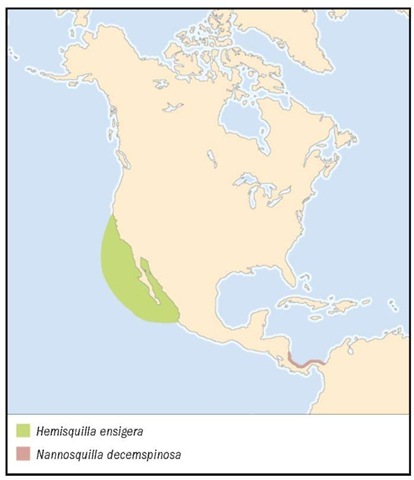
REPRODUCTIVE BIOLOGY
Males seek out females, displaying before females in their burrows; female makes the final choice of partner. Male fertilizes female, guards her until the larvae have left for the open sea, then departs.
CONSERVATION STATUS
Not listed by the IUCN.
SIGNIFICANCE TO HUMANS
Individuals of this species often end up as pets in public reef aquaria. Its punch is nearly equal to the impact of a .22 caliber bullet.
No common name
Lysiosquillina maculata
FAMILY
Lysiosquillae
TAXONOMY
Lysiosquillina maculata Risso, 1816.
OTHER COMMON NAMES
None known.
PHYSICAL CHARACTERISTICS
One of largest mantis shrimps, adults routinely attaining lengths of 15 in (38 cm) or more. Coloration in males tends toward the cryptic, being predominantly dark-speckled gray, brown, and dull orange. Females are a more conspicuous orange color; both sexes have distinctive, alternating light and dark transverse bands on the dorsal abdomen.
DISTRIBUTION
Eastern North Atlantic and Mediterranean.
HABITAT
Muddy sea bottoms, coastal to upper-slope continental shelves.
BEHAVIOR
Spearer, digs out burrows in sea bottom mud, then sits patiently in entrance for passing prey. Adults form monogamous pairs.
FEEDING ECOLOGY AND DIET
An individual waits at entrance of burrow, its forequarters partly exposed and its eyes aloft and alert. When an edible, soft-bodied creature, often a fish, passes within range, it springs forward, whipping its raptorial appendages from beneath body, then forward and upward, impaling the prey on the spearlike projections, then hauling in the prey.
REPRODUCTIVE BIOLOGY
Form monogamous pairs that may remain together as long as both partners are alive. Male guards the brooding female and hunts food for both of them.
CONSERVATION STATUS
SIGNIFICANCE TO HUMANS
None known.
No common name
Nannosquilla decemspinosa
FAMILY
Nannosquillidae
TAXONOMY
Nannosquilla decemspinosa Rathbun, 1910.
OTHER COMMON NAMES
None known.
PHYSICAL CHARACTERISTICS
Only 0.98 in (2.5 cm) long, and cryptically colored.
DISTRIBUTION
Pacific coast of Panama.
HABITAT
Shallow, muddy sea bottoms close to shore.
BEHAVIOR
Has attracted special attention from biologists, because, when beached by tides or storms, it moves itself around and back into the ocean by rolling up its body and rolling like a self-propelled wheel, covering as far as 6.5 ft (2 m) at a sprint, rolling 20-40 times, at 72 revolutions per minute, or 1.5 body lengths per second. When the rolling animal slows down, it uses its entire body as a spring to propel itself upwards and forwards into the next roll. So far, it and the caterpillar of the mother-of-pearl moth (Pleurotya ruralis) are the only two known animal species above microscopic size that use this form of locomotion.
FEEDING ECOLOGY AND DIET
A spearer, it is a passive hunter, waiting at the entrance of its burrow, and striking out with its raptorial appendages to impale soft-bodied prey.
REPRODUCTIVE BIOLOGY
Males seek out females, displaying before females in their burrows; female makes final choice of partner. Male fertilizes female, guards her until the larvae have left for the open sea, then departs.
CONSERVATION STATUS
Not listed by the IUCN.
SIGNIFICANCE TO HUMANS
Its ability to roll like a wheel renders it an object of fascination and a subject of scientific curiosity.
Peacock mantis shrimp
Odontodactylus scyllarus
FAMILY
Odontodactylidae
TAXONOMY
Odontodactylus scyllarus Linnaeus, 1758.
OTHER COMMON NAMES
None known.
PHYSICAL CHARACTERISTICS
Reaches lengths of 6.7 in (17 cm). Impact of its strike equals or exceeds that of H. ensigera. There is considerable sexual dichromatism. Mature males are brilliantly colored, with emerald green bodies and crimson and blue antennules and maxillipeds; females are more cryptically colored with olive or brown. Juveniles are bright yellow. An odd feature is its telson, which is thin and weak, despite the strength of the predatory strike, which is so powerful that it can kill an individual in a confrontation between same-species rivals.
DISTRIBUTION
Indopacific Ocean, including Hawaii.
HABITAT
Coral reefs.
BEHAVIOR
Smasher; diurnally active, but may also go hunting nocturnally during a full moon. When building a burrow, an individual lines the interior with pieces of coral, rock, and shell.
FEEDING ECOLOGY AND DIET
Actively hunts hard-shelled animals like clams, snails, and crabs, splitting shells with repeated blows of its raptorial appendages, then dragging the prey back to the burrow.
REPRODUCTIVE BIOLOGY
Males seek out females, displaying before females in their burrows; female makes final choice of partner. Male fertilizes female, guards her until the larvae have left for the open sea, then departs.
CONSERVATION STATUS
Not listed by the IUCN.
SIGNIFICANCE TO HUMANS
Favored for keeping in private aquaria.
